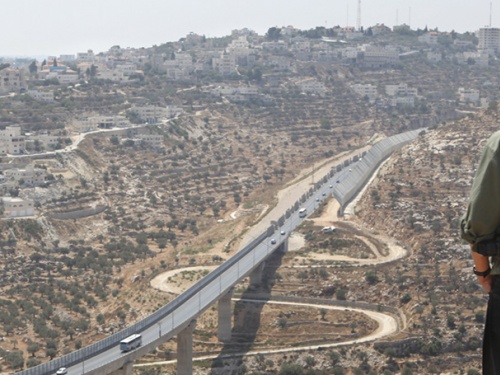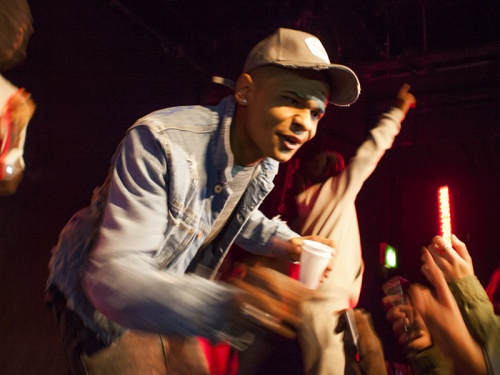TEXT2SPEECH: Documentary Tactics
TEXT2SPEECH is a series of reading groups organised by the ICA Student Forum to provide a space for debate around an eclectic range of texts, with each meeting topically responding to a part of the ICA’s current programme. The group is free to join and open to all, encouraging anyone with an interest in contemporary art and theory to join either regularly or for one of the meetings.
ICA Student Forum members Kelise Franclemont and Jane Scarth summarised the latest discussion.
For the TEXT2SPEECH session on 1 April 2015, participants were invited to review two texts that draw upon themes in the recent ICA exhibition, Dor Guez: The Sick Man of Europe. In this rich and engaging discussion, the readings served to contextualise Guez's exhibition as well as provide a space in which to share interest in the culture and art of this region.
The primary reading, No Occupation Without Representation - Artists in Palestine by HG Masters from ArtAsiaPacific (2011), centres around the work of Palestinian artists who have largely resorted to "documentary tactics" such as film, performance and photography in order to "address the urgent subjects of modern Palestinian culture: dispossession, nostalgia, exile and resistance." The second text by Rona Sela for Ibraaz, Rethinking National archives in Colonial Countries and Zones of Conflict (2014) offered insight into how Zionist archives form part of "a powerful institutional system", and how this cache of photographs, documents and films may be re-read to "hear the voices of the oppressed, learn their history and restore their ownership and rights."
The group focussed first on the artwork of Dor Guez. Guez makes work which relies heavily on the use of the archive, building stories around the complexities that result from a composite identity, born in a shared land of tumultuous history. We pondered on how Guez focuses on his particular cultural identity and claims a binary set of nationalities, each with its multiple histories. In a recent artist's talk with Simon Grant, Guez described himself as Jewish and Christian, Tunisian and Palestinian, Arab and Israeli, and was quick to highlight the other if any one of these strands was left out of the discussion. This ever-present duality of identity appears in Guez's film, The Artist, in which two stories are blended: the folk-tale of an impossible love story between a lady-bug and a mouse, mixed in with the memoirs of an artist unwillingly conscripted into the Israeli Defense Force in the 1960s. In both elements of the film, the protagonist often finds his carefully crafted identity at odds with his origins, and is challenged to truly belong anywhere.
Comparing Guez's work to the contemporary Palestinian artists, the question arose: how do these artists emphasise the nature of control under occupation? Our attention was drawn to the Picasso in Palestine project by Khaled Hourani, in which the artist worked from 2009 to 2011 to borrow Picasso's Buste de Femme from a Netherlands museum, for a month-long display in Ramallah at the International Academy of Art Palestine. From the project's inception to the twice-delayed exhibition over two years later, Hourani documented everything from the logistic to the legal, covering aspects of the Dutch, Israeli and Palestinian authorities. Whether or not the portrait actually made it to Palestine seemed beside the point of the project, which tested the boundaries of the occupation and thereby "forced it to reveal its systemic, bureaucratic and often invisible forms."
The conversation then moved to the second reading by Rona Sela, in which she discussed how documentary photographs form a crucial element in "a control mechanism that oversees the construction of meaning [and through such] ideological activities affect the representation of the conflict and its evolution in the public consciousness". Sela concludes that this bank of seemingly innocuous images, when considered aside from their original purpose—such as marking progress or military reconnaissance—reveal a certain unbridled violence in the creation of the new state.
These archives were inaugurated pre-1948 and after, and come from civil establishments including The Central Zionist Archives, Jewish National Fund and The National Library of Israel, among others. Military photography archives serve military and national security interests for the Ministry of Defense and the Israel Defense Forces (IDF) and other para-military organisations. Sela notes that, despite the extremely rich and varied content, the Israel's National Archives are commonly unavailable to non-state related analysts. Thus, Sela offers an alternative for these national archives of photos, films, and documents; by examining them with research questions that are more anthropological than military, these documents are released from their original intention, to become a voice that is critical of the occupation.
Near the end of our session, a final question emerged for consideration on the commute home: how does leaving a place as an artist—a homeland or birthplace—lead to changes in one's political position? ■
Join us on 22 May for our seventh meeting, where we will read an art-based publication back-to-back and to use the magazine or journal as a platform to explore and discuss contemporary issues of 'writing as practice', art publishing and art writing in a broader realm.
Tagged with: ICA Studentforum, learning, TEXT2SPEECH, Kelise Franclemont, Jane Scarth, Dor Guez, Palestine, Middle East, Archive






